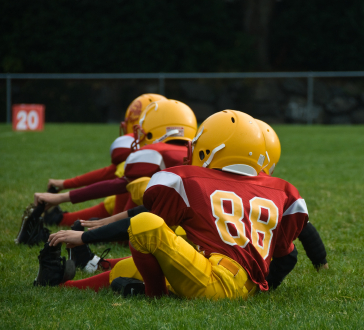
High school athletes suffer the most sport-related concussions, but concussions have doubled among younger athletes in team sports, says a new study.
Troubling statistics
Reviewing data on concussion-related emergency department (ED) visits for patients between the ages of 8 and 19 years from 1997 to 2007, researchers found that:
-
U.S. children aged 8 to 19 years made over one half million trips to a hospital emergency room for concussions over a four year period of 2001 to 2004, roughly half for sport-related concussions.
-
The 8- to 13-year-old age group accounted for 40 percent of the sport-related concussions.
- ED visits for concussions in organized team sports were highest in ice hockey and football.
-
Overall, the most ED visits for concussion in individual and recreation sports were in snow skiing, bicycling, and playground activities.
- Although participation in the top five organized team sports (football, soccer, basketball, baseball and ice hockey) declined over the ten-year period, ED visits for concussions in 8- to 13-year-olds doubled, and they more than doubled in the 14- to 19-year-old group, increases the study found "very troubling."
Higher rates in football, ice hockey
That the study found concussion rates for ice hockey (10 per 100,000) and football (8 per 100,000) among younger athletes ( 7- to 11-year-olds) much higher than the overall concussion rate (1 per 100,000), were "not surprising" to lead author, Lisa L. Bakhos, M.D., a Pediatric Emergency Medicine Attending at Jersey Shore University Medical Center in Neptune, New Jersey. "We see more head injuries [in the pediatric emergency department] due to ice hockey and football than any other sport by far."
Asked to explain the higher concussion rates in young athletes, however, Dr. Bakhos didn't have any definitive answers. "Overall, sports medicine professional speculate that sports for younger children are getting more and more competitive. That can only lead to increased collision intensity as players play harder. But this is something we need to investigate further."
Concussions: young athletes not immune
"The most important takeaway of the study for parents is that they should be aware that concussions can happen to anyone," said Dr. Bakhos. "Some may think, my child is too young to get really hurt in sport, but that is not the case. That is not to say that children should not participate; they should. Participation in sport is great exercise, great for socialization, and great for development. But safety measures should always be taken, and if a child has an injury, it should be taken seriously," Dr. Bakhos says.
Prevention strategies
In particular, Dr. Bakhos said that the study's finding that the majority of ED visits in the 8- to 13-year-old group for individual and leisure sport-related concussions occurred during cycling, playground activities, snow skiing, skateboarding and horseback riding, should "say a lot" to parents in terms of the safety of these activities and prevention strategies.
"Often times, we take for granted that our children will be safe when they are at play. We need to be aware that head injuries do occur and often. So our children need to protect themselves by wearing helmets whenever possible. This is especially true in skiing, where there is not much helmet use overall."
In addition to calling for state laws mandating the use of helmets in alpine activities, the study also recommends such prevention strategies as securing and padding soccer goal posts, as well as enhanced education for coaches, trainers, parents, and the athletes themselves to promote increased reporting and proper management of sport-related concussion.
Cognitive rest, conservative management urged
The study calls for "additional research and injury prevention strategies into [sport-related concussions] .. especially ... for the young athlete," and to "standardize the management of [sport-related concussion] in young athletes.
While acknowledging no evidence-based, concussion management guidelines for younger athletes yet exist, the study emphasized the agreement of experts "that young children cannot be treated in the same way as older adolescents." Until guidelines can be developed, the study suggests following the recommendation of the 3rd International Conference on Concussion in Sport in 2008 that younger athletes get cognitive rest after a sport-related concussion, and that their concussions be treated more conservatively than for older athletes, with no same day return to play and a more gradual overall return to play.
Take concussions seriously
The bottom line: "Parents need to be aware that concussion is a serious thing and can have serious long term consequences (especially in those with multiple events). They need to take prevention strategies and medical recommendations seriously to protect their kids," concluded Dr. Bakhos.
Source: Bakhos, L, Lockhart, G., Myers, R., Linakis, J. Emergency Department Visits for Concussion in Young Child Athletes. Pediatrics 126(3); e-550-556 (September 2010).
Created September 1, 2010








